How To Pick A Good Watermelon
Here are six tips for How to Pick a Good Watermelon that’s ripe and sweet, gathered from lots of conversations with produce people, farmers, and personal experience. If you know how to check for things like the field spot, it makes the selection process much easier!
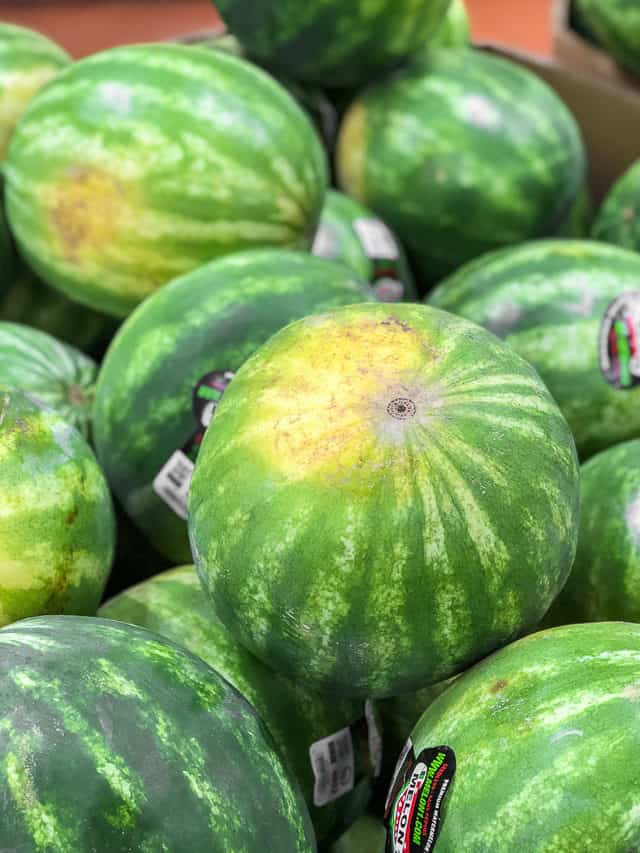
Picking out a perfect watermelon at the grocery store was always a semi-anxiety plagued experience for me when I didn’t know what I was looking for.
If you pick a bad one, you’re stuck with 15-20 whopping pounds of watermelon terribleness. And then your options are to either force yourself to eat this yucky watermelon or throw it away…and both are less than desirable options.
There have been a few times where I ended up throwing it out because it tasted like a crunchy watermelon rind cucumber, and no one in my family would eat it.
My goal today is to help you pick a sweet, ripe watermelon because I know how disappointing it is to get home, take your first bite of some sort of produce you buy, only to find out it isn’t good.
All the tips here are tidbits I have gathered from personal experience and lots of conversations with produce people and farmers. Here’s how to pick the best watermelon!
Tip #1: Find the Field Spot
If you don’t even read the other tips, I find this is the biggest indicator of a good watermelon.
The field spot, or ground spot, is a creamy spot on the outside, and it’s where the watermelon was resting on the ground, or the underside of the watermelon.
The field spot should be a yellowish creamy color, like shown with my watermelon:
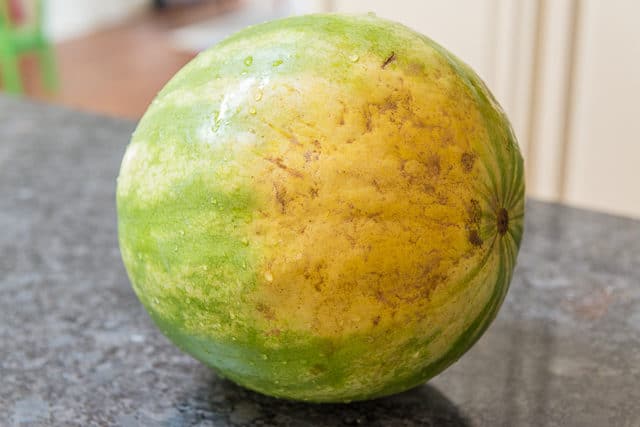
The more dark yellow the field spot is, the longer it was on the vine sweetening up. If the field spot is a white spot (or not even there), this indicates an underripe melon.
What’s interesting is you’ll notice that the other side of the same watermelon looks completely different:
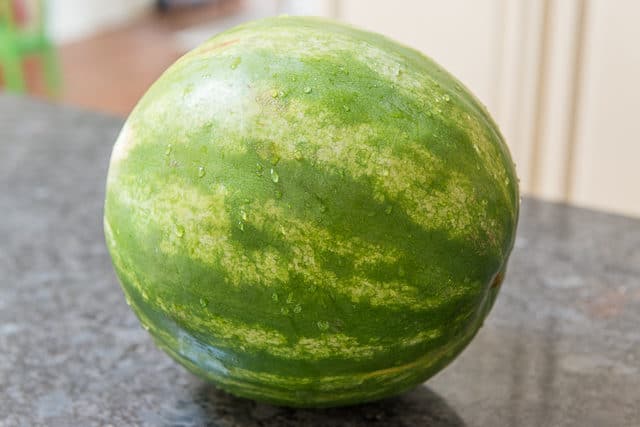
It’s much prettier and more typical of what I picture when I think of a watermelon, and that’s okay.
I find that the best watermelons I buy can sometimes look really gnarly on one side, usually the underside of the melon where it was resting on the ground, and then unblemished on the other. But you don’t want it to look perfectly green all the way around.
Note: It’s fine if there are green stripes, or not, or if there’s solid green color on most of the outside of the watermelon. The exterior pattern is more about the varieties of watermelons that your grocery store carries, and not anything to do with being a ripe melon or not.
Tip #2: Pick a Dull Looking Exterior
A shiny exterior appearance indicates an underripe watermelon, though this can be a bit tricky if they’ve added wax, and then you can’t really tell. This applies to honeydew melons too. Don’t be put off by a dull looking watermelon.
Tip #3: Knock on It with Your Knuckles
Your knuckles should bounce off the melon, and the surface should be pretty hard and firm. You will get a dull thud if the flesh is soft, which indicates it’s starting to spoil. Avoid any melon with soft spots!
Rather than a dull thud, you are looking for a hollow sound, a deep sound. It takes a lot of testing to learn what this sounds like, so don’t use it as your only indicator.
If you don’t want to knock with your knuckles, then you can push firmly with the tip of your thumb. Ideally there should be little or no give when you push in.
Tip #4: Get the Heaviest One for Its Size
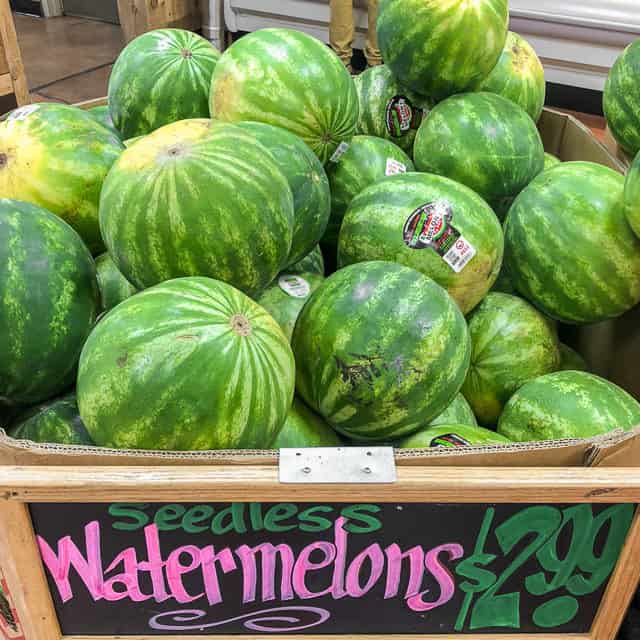
This applies to pretty much all produce, but you want to pick a heavy watermelon, meaning the one that is the heaviest for its size. That means there’s more water in it, which means a juicy watermelon.
The easy way to check for this is to pick up a few melons and compare their weights (or, if there’s a scale nearby, actually weigh them).
The whole watermelon pictured above here in my post was a whopping 18 pounds! It was heavier than the other comparably sized melons around it. It’s more bang for your buck too.
Tip #5: Check for a Uniform Shape
Some watermelons are round, some are oval, and either is fine. They are just different varieties. But if there are irregular bumps, this indicates the melon may have gotten inconsistent amounts of sun or water, and you should avoid that one.
Tip #6: Look for the Sugar Spots and Pollination Points
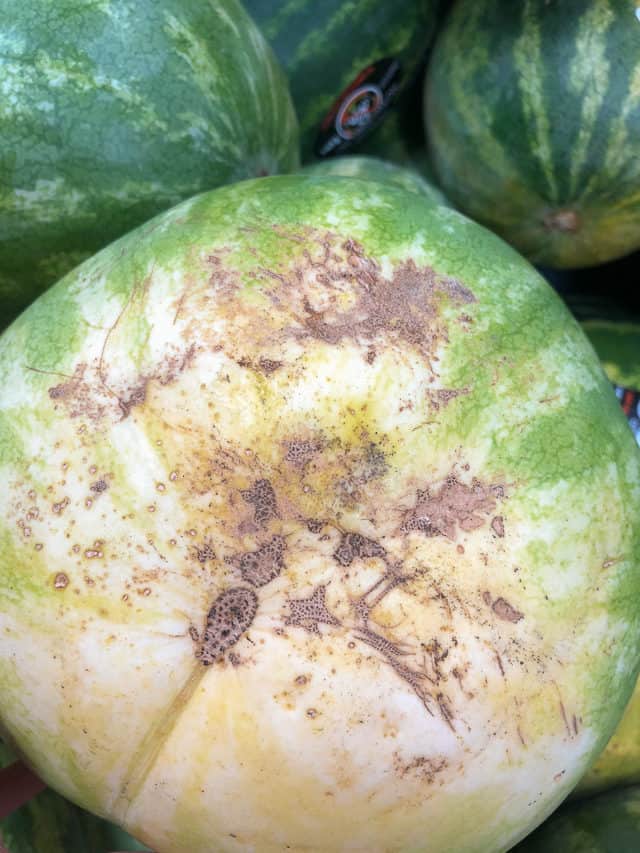
This tip was emailed to me many months ago by Tom, a produce manager for a major grocery chain. If you see black spots on the melon (as pictured above), this is where sugar is seeping out and indicates a sweet melon. At first glance, a sugar spot might just look like dirt, but if it doesn’t rub off easily, then it’s a sugar spot.
Also, if you see dots in a line (not a scratch), these are pollination points, and the more of them the better. I’ve been looking for these every time I pick up a melon and have had great luck with it in addition to the other tips. Thank you, Tom!
Though the above melon did not have a creamy yellow spot (it’s a little white), the sugar spots are a good sign. It was indeed a sweet watermelon.
What about the stem?
I’ve never seen a watermelon with its green stem on, though perhaps you’re more likely to find one at a farmers market. Odds are it won’t come up anyway, but I don’t know if any ripeness indications from the stem.
Once you’ve picked out a good watermelon, take a look at my quick guide for How to Cut a Watermelon, which is how I always cut watermelon to keep in the fridge. But is especially the best way to serve this delicious fruit for parties and entertaining.
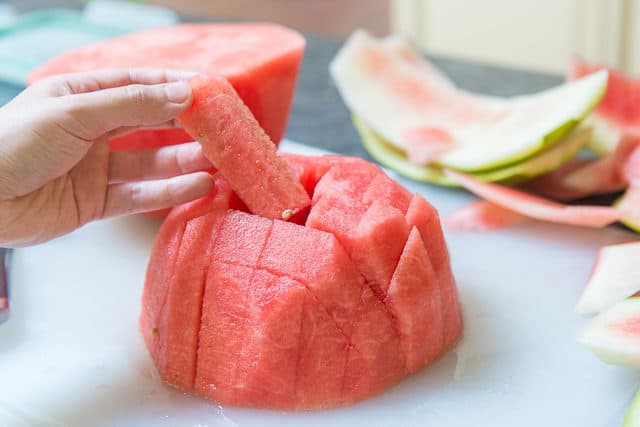
The middle of the watermelon always has the best flavor, so you’ll want to cut away a substantial amount of rind.
This method of cutting is SO much easier than cutting the typical triangles that include the rind, and you can either cut it into sticks or cubes. My perfect slice is actually the stick!
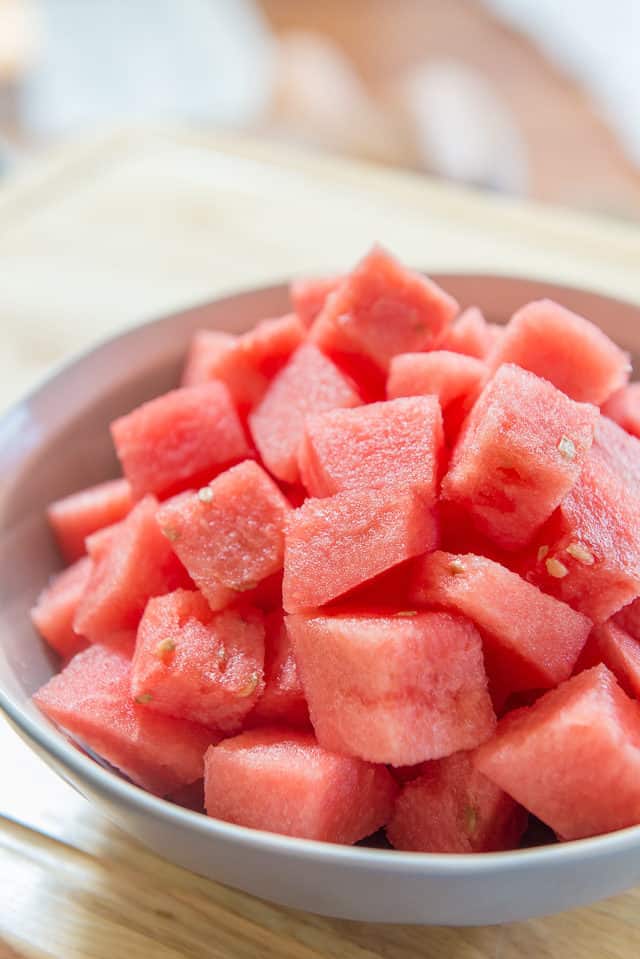
Just make sure to use a sharp knife so you get crisp pieces.
Click the photo above for my guide on cutting. Enjoy watermelon season!
More Tips and FAQ
If it’s cut, the watermelon must be stored in the fridge and can be kept in a large container for up to 5 days. An uncut watermelon can be kept at room temperature for a few days, but I find it’s best to get it into the fridge as quickly as possible, especially since watermelons do not ripen further on the counter.
Yes, but it’s not something you’ll want to eat again in a thawed state. I freeze watermelon to blend into a Watermelon Slushie or as ice cubes for Summer Drinks.
In the South they serve pickled watermelon rinds as a kind of relish, and it’s very good! I’ve never made it myself though. Only had it in restaurants.
Did you enjoy the recipe? Please leave a 5-star rating in the recipe card below and/or a review in the comments section further down the page. Or, follow me on Facebook, Instagram or Pinterest!
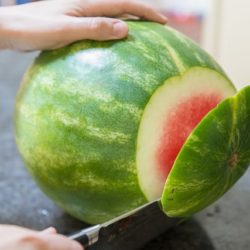
How to Pick a Good Watermelon
Ingredients
- 1 large watermelon
Instructions
- Find the Field Spot – Look for a deep yellow color. If there’s a white field spot, or no field spot at all, it likely won’t be good.
- Pick a Dull Looking Watermelon – A shiny appearance indicates an underripe melon.
- Knock on It with Your Knuckles – Your knuckles should bounce off the melon, and the surface should be pretty hard/firm. Soft flesh indicates it’s starting to spoil.
- Get the Heaviest One for Its Size – This applies to pretty much all produce, but you want to pick the watermelon that is the heaviest one for its size. That means there’s more water in it.
- Check for a Uniform Shape – Some watermelons are round, some are oval, and either is fine. But if there are irregular bumps, this indicates the melon may have gotten inconsistent amounts of sun or water.
- Look for the Sugar Spots and Pollination Points – If you see black spots on the melon, this is where sugar is seeping out and indicates a sweet melon. Also, if you see dots in a line (not a scratch), these are pollination points, and the more of them the better.
- If you want an easy way to cut the watermelon into sticks or cubes, see my How to Cut a Watermelon post. Enjoy!
Nutrition
Nutrition is estimated using a food database and is only intended to be used as a guideline for informational purposes.
Post updated with new photos and more tips in June 2018. Originally published April 2011.

288 Comments on “How To Pick A Good Watermelon”
What knives do you use/own?
I have quite a hodgepodge of knives. I started out with some cheaper ones (Wusthof stamped knives, Chicago cutlery) but eventually got some Shun knives which are my favorites. I also have some Japanese one I got from my stepdad but I don’t know what it’s called. If you’re looking for a good knife, I would say just make sure it’s hand forged, not stamped, and you can find some good reviews on Amazon.
Love my Wusthof’s and at $500 for a 7-9 piece set they are a huge step up from most knives that I think of as cheaper.
I live in the South and we live watermelon! Unfortunately, I am allergic to it now 🙁 But I can still enjoy the watermelon rind pickles!!!! They are so good!
Hi, I see that you have a “pin it” button, and then next to that you have a copyright notice that images cannot be duplicated, which seems a little contradictory. I was just wondering if it was ok to “pin” your images to Pinterest? I don’t want to infringe on a copyright! Thanks.
Hi Jane, Ah yes, I can see that. The copyright notice is to try to deter people from copying and pasting my entire posts and claiming it as their own (it happens constantly). Pinning is definitely fine. I will try to work on my wording =)
Thank you!
all the tips are great and I do one more thing. I let the watermelon sit for 3 days at least and then cut.
Curious as to why you let it sit for 3 days
In the fridge?
My grandpa tought me to look for the little grey strips that have black dots in them. He said they were bee stings, and that was the sweetest because the bees could tell better than we could. It has worked pretty good for me.
You might mention how important it is to wash watermelons. They can lead to food-borne illness, but often don’t get washed…icky!
oh, wow! you are my hero! my husband LOVES watermelon, and I get to not only buy it but cut it as well. so your post is a goldmine for me! thanks so much!!
I usually buy my melons from the grocery store (we have bilo, walmart, food lion and ingles most prevalent around here). I really don’t think they would cut open the melon! Especially if I tasted it and didn’t like it! There is no giving it back…not to my knowledge. Most places I’ve been to, I always thought it was you buy it then cut it up at home. What kind of places would let you sample a few different melons before you decided which one you wanted, if any?
Curious,
Britt
Hi Brittany, I shop at Publix and Whole Foods, which are well known for good customer service, and they also sell cut watermelons, so this is possible at those kinds of stores. I am familiar with Walmart but have never shopped at a bilo, food lion, or ingles. I guess it depends what their policies are. Whole Foods for instance lets you return food you don’t like or weren’t satisfied with, so if I don’t like something I just return it, and they also encourage you to taste things if you want to (or at least, the Whole Foods by my house does this haha).
I have worked in produce at two different commissaries (military grocery store). The smaller one I worked at, we used to cut up the melons for people all the time. The second one I worked at, our manager didn’t care all that much about customer service so he didn’t allow us to. My point being, I think it just depends on the specific store and who runs it.
I am a Military Wife and I am just wondering why the produce at the commissary sucks. At least at Bliss it does. I can not even buy bananas unless we plan on eating them that day or they go bad. Do you know why this is?
I have been told that it’s because they buy from whoever is willing to give them the lowest price. I agree, the commissary can be pretty bad for produce, but I have found it varies a lot from commissary to commissary. The one I’m at now is actually decent!
No kidding! Been to dozens of commissaries, growing up military and inlaws retired military, I’ve never seen any of them with good produce.
I know Safeway and Fred Meyers allow you to sample any food. If you ask a sales associate to taste a melon, they have to cut it. that goes for a candy bar, a loaf of bread….anything. They want happy customers.
I only have a Walmart and a Safeway in my little town. Both of these stores will let you return produce if it wasn’t good. Just bring your receipt back and any unused portion of the product, and they will replace it. No questions asked. My Safeway also offers samples of the fruit, which I might talk to them about! I never took samples, but now I have good reason. I know they don’t wash the fruit before they cut it open because I’ve watched them do it. It is a sad day when we have to be THIS careful with food!
LOL! Watermelon Jenga….. LOVE it! Thanks for the tips on picking out a good watermelon, too!
Hey, thanks for sharing this. I’m a big fan of watermelons and now u made it easy to choose them and cut them. Thanks once again..:)
Anagha
Not a fan of the watermelon thump advice. I raised watermelons in my younger years and a REALLY solid thump is a sign of an over-ripe melon. A deep but solid thump is a melon that can be delicious. A high pitched thump is a sign of an unripe melon.
I think all of your suggestions were wonderful except for one. My husband and I own a Farm Market in Michigan and we grow our own watermelon to sell there along with tons of other produce. We are actually prohibited by law from cutting up produce for customers to sample. It poses too much of a health risk without a proper licensed kitchen to wash and cut the produce in. So, while I think sampling produce is a great sales strategy, readers, please do not assume that a farmer is trying to hide something by not offering samples and I would be wary of sampling produce anywhere that a licensed kitchen is not in sight. Just a little insight from a girl in the produce biz. 🙂
Hi Allissa, I’ve never been to a watermelon farm, how neat. All the groceries around here sell cut watermelon and they cut it in the kitchen for me. That makes sense that a farm wouldn’t do that…especially if it’s illegal. That’s pretty intense! Thanks for sharing your insight.
Great point !
My Grandma and Mom stressed NEVER never take a sample from a farmer selling fruit….Thier theory was that you never knew if he cut his toenails with the knife he used to cut your sample !
Good grief your momma and I must be related as I say the same thing! 😉
~Honey
I don’t laugh a lot or think many things funny…but that was funny. Thanks for the insight.
Thanks for the tips! I always cut my watermelon this way and it works so much better than the way I used to do it a long time ago. I have never been good at picking melons with the thumping method, what I do is very lightly run my fingernail over the skin if it comes off easily I have always gotten a perfect tasting melon! It doesn’t work if you have fake nails on but just lightly scrape and if the skin comes right off that means tasty! I will definitely try some of the other tips in the future to see how it works for me!
You forgot a critically important step – wash that baby before cutting into it. Watermelon grows on the ground where it lays on dirt and is available for any nearby wildlife, or farm dog can pee on it. If you don’t wash it first, and cut into it, any residue on the outside will be pulled into the melon. All produce should be throughly scrubbed in warm water with a vegetable brush. You don’t need any soap, but a little vinigar in the water is my preference. If you have the store cut it open for you, make sure they scrub it too.
You sound like Howard Hughes without the money. You are probably better off not eating fresh fruits with that kind of attitude. Washing lightly is enough, and has been for thousands and thousands of years.
Washing is important less because of possible dog pee or even booger hands but because of potentially dangerous bacteria. If you look at the news a lot of cases of people getting salmonella or other types of food poisoning is from unwashed produce and not necessarily under cooked meat. Grocery stores sell a lot of things besides fruit and you don’t know how stuff is transported. Light washing may have been good for thousands of years but people also died from preventable diseases for thousands of years. Not saying you need to bleach it or anything, but a nice rinse with a touch of soap or vinegar sounds like a good idea to me.
Also, my father-in-law (60 yr old southerner) got sick from unwashed watermelon once and now he pretty much insists on washing it as well.
It might change your opinion when I tell you that sometimes the people who pick the fruit pee in the fields. I’m a lot less concerned about the dog. Regardless, after you comment, wouldn’t you feel a little guilty if someone followed your advice and ended up in the hospital or dead? People die every year because of this. Just let her wash her fruit with vinegar! Makes no difference to your life.
Yes workers pee on the produce…I was mortified to learn of workers peeing in the lettuce, they thought it was funny to see the pee come foaming out of iceberg lettuce.
Nasty!
Please wash your produce!
Yuck! I felt better not thinking about that. However, will be healthier scrubbing the heck out of my produce. I always wash but now that you say that maybe not enough:) Like others, I wasn’t as concerned with animal pee. I was mostly concerned with pesticides, but now also with farm workers having fun at my expense!
Geeze when we were kids (living in Montana), we only had watermelon in the summer at the lake. My dad picked out the melon at put it in a fishing net and placed it in the lake to stay cold! I dont think it ever crossed his mind to wash it first! We saved the rind for grandma and she made watermelon rind pickels. How times have changed!
I totally agree – I’ve worked in grocery stores & have seen first hand just how nasty some of the employees handling the produce can be, and that’s on top of whatever could have made a “deposit” on the fresh fruits & veggies when they were still on the ground, vine or in the tree. It’s just a good practice to wash this stuff, I don’t think it’s being pretentious or anything, just a way to avoid germs. Think about all the booger-fingered kids in the store who have touched all that stuff as they walk past it too…..LOL!
what happen to drinking water from the water sprinklers at the park!? wash the fruit with a vegetable brush? really…..I pick the apples give it a wipe with my shirt and take a nice crisp bite! strawberries ……I’ve eaten the in the field right after I picked it! lets live a little…..this is why are youth is obese you’re giving them too many steps! hahahaha
I couldn’t agree with you more. People worry too much about stuff now and do not live. Everyone is more worried about what will happen if I do or dont do this… Really watch a kid for a day and take their way of living into perspective. As a kid did you ever consider what was going to happen when you rode your bike without a helmet, or what happened when you picked up that frog or bug.. NO Life needs to go back to the way things used to be. People would be much HAPPIER and there would be much less stress in the world… Live Life and enjoy it, you only get 1.
YES! There was a lot of folks getting sick last year from eating cantaloupe. Because cantaloupe has a rough surface, bacteria especially likes to hide in its pits. When you run a knife through the outer layer into the meat the bacteria goes with the knife. Wash cantaloupe carefully and thoroughly!
I just want to thank you for this past post of yours. I discovered it on Pinterest, saved the info to a memo on my phone, then referred to it the next time I shopped for a watermelon. I no longer need to refer to the memo, but I still follow your suggestsions when I shop. I am happy to say, we’ve had 4 good watermelons in a row, since I discovered your advice. THANK YOU!
Renna, that is wonderful! So glad to hear it! Glad I can help you pick great watermelons =)
“If you really want to make sure the watermelon is good, ask them to cut it open for you and let you try it. I’ve started doing this recently ever since a produce guy offered to let me taste.”
Really? Where do you live? I don’t know of ANY store that would honor your request! LOL
Really? I don’t live anywhere special…just a medium town in Georgia. Every store in town will do it. Whole Foods, Publix, etc. The only reason I did this was because the produce person offered. Ordinarily though I just buy one with the tips and I get a good one. But in general, if I buy something in the produce section and it’s bad, I take it back for a refund.